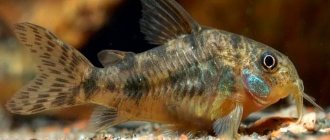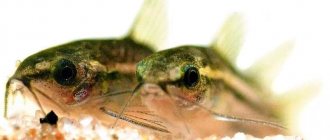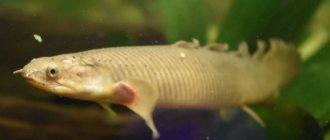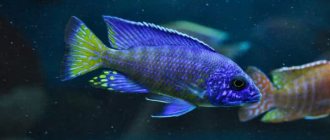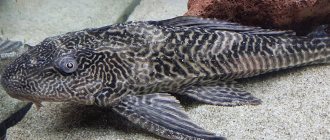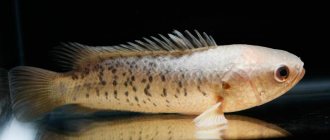Acantophthalmus Kühl (lat. Pangio kuhli) is a species of fish of the family Cobitidae. This is an unusual, peaceful, and beautiful species of loach that is very often found in aquariums. Its behavior is typical of all loaches; they are constantly on the move, constantly searching for food in the ground. Its disadvantages include a nocturnal lifestyle and caution; as a result, acanthophthalmus is difficult to see in the aquarium during the day. Next, you will learn how to keep, feed, breed and select fish compatible with Kühl's acanthophthalmus.
Description
Acanthopthalmus has an interesting body shape, making it look like an eel or snake. The maximum length of acanthophthalmus is 12 cm.
Appearance
The body is oblong, slightly flattened in the tail area. The fins are small in size, the dorsal one is located closer to the tail. The color of acanthophthalmus is yellow-orange with 10–20 brown stripes. There are small antennae near the mouth that help the loach find food.
Lifestyle
In nature, it lives in small groups, but solitary confinement is also possible. Acantophthalmus is nocturnal. Prefers shaded places. During the day it hides among shelters. It is more active when keeping 4–5 Kühl fish.
Behavior
The acanthophthalmus fish is a peaceful and calm inhabitant of the waters. It lives in the lower layers of water and digs in the ground. Shows shyness towards other species. Doesn't eat plants.
Lifespan
Külya lives up to 10 years with good care.
Breeding
In nature, the spawning period of fish occurs in December-January. Acantophthalmus Kühl is distinguished by its method of reproduction - they lay sticky green eggs on the roots of floating plants. However, achieving spawning in a home aquarium is quite difficult. Injections of gonadotropic drugs are used for breeding; their use requires experience and understanding of the process.
As one of the means of stimulating spawning, experts call imitation of the beginning of the rainy season (it is advisable to combine it with an atmospheric pressure wave). You should make the water in the aquarium softer, lower its temperature, and reduce the intensity and duration of lighting.
Cases of successful reproduction of acanthophthalmus in an aquarium are quite rare. Sometimes, under good aquarium conditions, fish can spawn in a community aquarium, but the eggs remain unfertilized and are soon eaten by the parents or other fish.
Content
Vyun Külya is unpretentious. For proper care, acanthophthalmus does not require expensive equipment or a large aquarium.
View this post on Instagram
Acantophthalmus Kühl - becomes more active in the evening with the arrival of twilight. #acanthophthalmus #acanthophthalmus #fish #funnyfish #beautifulfish #aquariumfish #aquarium #aquariums #underwaterworld
A post shared by Evgeniy Aquariumist (@aqua.fish.club) on Jul 24, 2021 at 9:46pm PDT
Aquarium
A 20-liter aquarium is enough for one individual. A group of 5-6 fish will require an aquarium with a volume of at least 50 liters. Covers required:
- grottoes;
- ceramic pots;
- caves;
- driftwood.
Water parameters
| Temperature | 21–26 degrees |
| Acidity | 3,5–7 |
| Rigidity | 1–8 dGh |
| Water movement | weak |
| Brackish water | No |
Change up to 20% of the liquid to settled liquid with similar parameters. Avoid sudden changes in temperature and hydrochemical composition. Periodically check the water with tests, especially in the spring, when the composition of the water is most unstable and dangerous for aquatic life.
Plants
It is necessary to have plants that grow in dim and weak light:
- Java moss;
- pearl moss;
- Anubias;
- hygrophila;
- ferns;
- cryptocorynes.
Kühl's loaches feel comfortable among dense thickets of plants. Mosses floating on the surface create shade, while mosses growing on the bottom act as shelters.
Priming
Select sandy or smooth soil of medium-sized fraction so that acanthophthalmus does not cut itself when digging in the soil. The pebbles should be dark. Do not place artificially colored soil in the aquarium, as the paint is toxic to aquatic life. Siphon the soil weekly.
Equipment
Equipment you will need:
- filter;
- compressor;
- heater.
Make sure that the devices do not create strong currents. A mechanical low-power filter will do. In the cold season, a heater is required; in the summer, cool the water using ice bottles immersed in the aquarium.
Lighting
Kühl's loaches prefer weak, diffused light. Daylight hours should last no more than 12 hours.
Motherland
The Latin name of this aquarium fish is Acanthophtalmus, Pango. In Russia, it received other names: acanthophthalmus, spiny-eyed loach, tropical loach, worm fish, snake.
The thin elongated body of the kuli throws the beholder towards the illusion of a small sea snake.
On average, a fishtail lives in an aquarium for no more than 5 years, even if comfortable living conditions are created for it.
In length, adult individuals have the following dimensions: females - 10-12 cm, and males - no more than 10 cm.
Under natural conditions, acanthophthalmus culea lives in rivers and streams in southeast Asia and India. They prefer to swim in channels and reservoirs where there is practically no current ; at the bottom there are snags, remains of tree roots and fallen leaves - this loach usually hides in them. And dim lighting helps nimble fish to better hide from their enemies.
These fish appeared in Russia in 1970, and three years later they began to be actively bred as aquarium fish.
Feeding
Acantophthalmus is omnivorous. Main components of the diet:
- sinking tablets and granules;
- bloodworm;
- tubifex;
- Artemia;
- zucchini;
- cucumbers;
- daphnia;
- gammarus;
- food with spirulina.
A properly formulated diet includes 80% protein and 20% plant foods. Make sure that when living with other aquarium fish that live in the upper and middle layers of water, the acanthophthalmus gets enough food. Avoid overeating. Once a week, have a fasting day.
Aquarium
Due to the fact that the aquarium fish Acanthopthalmus leads a bottom-dwelling lifestyle, the shape of the aquarium should be rectangular or square. Round tanks are not suitable for fish with a snake-like body, as they do not contain enough usable space.
If you plan to breed 5-6 acanthophthalmus, then this amount will require 70 liters.
The reservoir must be covered with a lid or mesh. The safety of pets depends on this. The lid will prevent them from jumping out of the water and dying unattended.
However, the violent temperament of fish does not always require the creation of cover. Loaches are real barometers, and when they begin to sense changes associated with atmospheric pressure, they begin to swim chaotically throughout the aquarium. Often such activity leads to the fact that the thorns, as they are also called, jump out of the water and break into nearby objects.
Aquarium with acanthophthalmus
Water parameters
The optimal temperature for breeding acanthophthalmus varies from +22°C to +28°C. At low temperatures, individuals get sick. Hardness level – 5 dH, acidity – 6.5 pH.
Small and adult inhabitants are sensitive to water indicators; if they don’t like something, they float to the surface. This behavior is not typical for this species, since acanthophthalmus prefers a bottom lifestyle.
Compatibility
Acanthopthalmus has good compatibility with non-aggressive fish and inhabitants of the upper water levels:
- tetras;
- iris;
- swordtails;
- platies;
- neon;
- rasborami;
- guppy;
- zebrafish;
- shrimp;
- corridors;
- mollies;
- gourami;
- peaceful barbs;
- scalars;
- parrot cichlids.
View this post on Instagram
Pangio kuhlii & Sewellia lineolata #pangio #kuhlii #pangiokuhlii #sewellia #lineolata #sewellialineolata #fish #fishfam #fishy #fishes #fish #fishing #fisk #fiske #fiskar #aquarius #aquarium #aquariumfish #fishtank #akvarium #akvariefisk #asien # kina #sverige #sweden #love
A post shared by Jimmy Pedersen (@jimmy_pedersen_fishroom) on May 4, 2021 at 1:16pm PDT
Acantophthalmus is incompatible with aggressive and predatory species, as well as exotics that are much larger in size and fish with different maintenance requirements:
- goldfish;
- astronotuses;
- akarami;
- small shrimp;
- predatory catfish;
- stingrays.
What to feed
Acantophthalmus are micropredators that sift pieces of substrate through their mouth and gills. Insect larvae, small crustaceans, etc. are extracted from it, with part of the natural diet consisting of organic detritus and plant material from the prey's intestinal contents.
In the aquarium, they should be fed dry food made from sinking pellets, but it is advisable to offer regular food from live and frozen food: daphnia, brine shrimp, bloodworms, microworms, grindal, etc.
Reproduction
Spawning of Kühl fish is seasonal. Cases of reproduction at home are rare; acanthophthalmus breeds only in large aquariums. Hormonal injections are often required.
Sex differences
Sexual dimorphism is very weakly expressed. Sexual maturity occurs at one year of age. The female is 2 cm longer than the male, the abdomen is larger. The first ray on the pectoral fin of the male is thicker.
Getting offspring
First prepare the spawning tank:
- You will need an aquarium with a bottom area of 1000 square cm.
- Set the water level to 20 cm.
- Include floating and rooted plants.
- Place a separator mesh on the bottom.
- Create moderate lighting.
- Acidify the water to pH 6.5–7, hardness should be 5–15 dGh, temperature 26–28 degrees.
- Perform frequent water changes up to 10% of the total volume daily.
Before injection, place the fish in a 3-liter jar and add two drops of novocaine or tricaine. When acanthophthalmus has frozen, you can inject human chorionic gonadotropin in a proportion of 60–150 IU. per individual. Inject into the dorsal muscle. The fish will be inactive for the next 5–8 hours. Move up to 5 acanthophthalmus into the spawning tank.
Spawning
The beginning of spawning is indicated by the manifestation of interest of males in females. Males hug females with their pectoral fins and press against them. The female scatters up to 700 eggs in total. Disappearing through the separator mesh, the caviar remains inaccessible to voracious parents. After spawning, return the parents to the community aquarium. Treat the water with mycopur.
Fry
After a day, the eggs hatch and swim independently within 4–5 days. Keep the water clean.
View this post on Instagram
Ugh, I just want October to come faster! #pangiokuhlii #20gallon #50gallon #kuhliloach #loaches #orangeandblack #remindsmeofhalloween #work #petstore #ontario
A post shared by Jessica Litt (@jesslitt13) on Aug 17, 2021 at 3:12pm PDT
Feed the Kühl fry:
- living dust;
- artemia;
- microworm;
- chopped tubifex;
- ciliates;
- rotifers.
After 2 weeks, a faint pattern appears on the body.
Interesting features
Acantophthalfus is notable not only for its serpentine body, but also for a number of other interesting features:
- The fish has several types of respiration - through the skin and using the air supply in the stomach. She gains it by periodically rising to the surface of the reservoir.
- Acanthus are true barometers of atmospheric pressure. When it fluctuates, they gather in flocks and actively move in different layers of the reservoir, although in a calm state they prefer a bottom lifestyle. This is explained by the peculiarity of the air bubble located in the body of the fish in a special bony shell.
- The spikes under the eyes look very unusual, but have a useful function. They help the fish make its way through thickets of aquatic plants. Acanthus, turning its head, clings to the grass with its shoot and pulls up its body. In addition, this is a serious and very sharp weapon. If a large fish swallows an Acanthus, the latter is capable of cutting through the stomach of the predator with its spines, killing the hunter and getting out to freedom.
- Acanthus are great at hiding. During the day they are difficult to find in the aquarium - they expertly bury themselves in the bottom filler or hide among thickets of algae and decorations, curling up into balls.
Diseases
Diseases appear due to injuries or incorrectly selected water parameters. An increased content of toxic substances (ammonia, nitrates, chlorine) also reduces immunity and provokes poisoning. If acanthophthalmus loses its appetite, looks depressed and its color fades, check the water with chemical tests. Külya is susceptible to diseases:
- Ichthyophthirosis (“semolina”). A white coating appears on the body, the fish tries to scratch itself on stones and other objects, becomes restless and loses its appetite. Treatment is accompanied by an increase in temperature by 2–3 degrees and increased aeration. Add the branded drug to the water according to the instructions. Make sure the medicine is safe for scaleless fish, otherwise reduce the dosage by half. As an alternative, use a solution of quinine hydrochloride (0.25 g per 1 liter of water). Apply the medicine three times every two days.
- Obesity. With overfeeding, abuse of dry food and monotonous feeding, acanthophthalmus develops obesity in the internal organs, which makes the fish’s body look enlarged. Put the fish on a diet with low-fat, high-quality food or a hunger strike. If the fish’s body is strongly spread out on the sides, the probability of curing the pet is low.
- Oodiniumosis (“velvet rust”, “gold dust”). Mucus appears on the body of the Kühl loach, the fins are pressed tightly, and the fish itches against the decorations. Later, acanthophthalmus becomes covered with a brown coating. Treated with special medications. When using copper sulfate, be careful and carefully calculate the dosage (no more than 0.2 mg per liter of water).
- Tuberculosis (mycobacteriosis) is a serious disease that occurs in contaminated aquariums and is transmitted from an infected individual. In the first stages, treatment with kanamycin or rifampicin is possible, which must be mixed with fish food.
- Skin and gill flukes are parasites that parasitize the skin of loaches and can be distinguished upon closer examination. Infected fish behave restlessly, itch, and redness appears on the body. Antiparasitic agents from pet stores are effective against trematodes. Carry out the full course of treatment, do not stop adding funds even when the fish looks completely healthy.
Popular types
Acantophthalmus is a group of aquarium fish consisting of several species. Their main differences are only in appearance.
Acantophthalmus Kühl
Outwardly, this species resembles eels: the body is similar to a snake, slightly compressed at the edges, with small fins. The oral cavity is lower, framed by 8 antennae, with small eyes covered with a film. Under each of them there is a spike.
Body color is pink or yellow with an orange tint and dark stripes (up to 15-18 pieces). The length of an adult can reach 11-13 cm. This worm can live 8-10 years in an aquarium.
Acantophthalmus Myers
This species has only 6 antennae near the mouth, as well as spines and a film on the eyes. The color of their body can vary from yellow to red; brown stripes are clearly visible on it - no more than 14 pieces.
Although the length of its body is the same as that of Culey, Myers's acanthophthalmus is thicker. The lifespan of this fish is no more than 5 years.
Acantophthalmus semi-girdled
The size of the serpentine body can reach 10 cm. The color of the back is brown, the belly is white with a yellowish tint. The rings surrounding it are clearly visible on the body, which is why the fish got its name.
Spiny-eyed loaches are very interesting fish with an unusual body shape. It is quite difficult to observe them, since they are nocturnal and usually hide in snags, stones or sand. But those aquarists who have already raised such fish in their aquariums speak of them with delight.
Reviews
A couple of years ago I “inherited” one acanthophthalmus, which was so skillfully hidden that it was almost impossible to see it. After a while, I acquired two more fish of this breed, the three of them began to actively look for places to hide. But after a few days they could go out in search of food even during daylight hours. I often watch them swim between driftwood and pebbles in the evenings. Maria, 30 years old, Moscow.
I have had fish of this breed for several years now, I call them Laces. A couple of times they got sick with semolina, but they were successfully cured. I moved them to a large aquarium, now they hide endlessly and only appear when I pour food into the aquarium. I'm thinking of buying a few more acanthophthalmus - these fish are interesting when there are a lot of them in the aquarium. Sergey Nikolaevich, 45 years old, Samara.
Photo
How to distinguish female and male
The sex of adults is usually determined without difficulty. During pregnancy, the female has a large belly, where greenish eggs can be seen. Thickening of the second thoracic ray, and sometimes the third ray, is characteristic of males of the species P. alcoides, P. incognito and P. pulla.
In addition, males can be distinguished from females using the pectoral and ventral fins, which are shorter in females than in males. This applies to most Pangio species.
Notes
The genus Pangio is one of the most specific of the Loaches and is widely distributed throughout South and Southeast Asia with a species diversity believed to be significantly greater than is currently recognized and described.
This genus has countless variations, both within and between populations, although most have the same basic pattern of dark saddle markings, usually wider on the dorsal surface, over a yellow-orange base color.
All Acantophthalmus species have sharp and mobile subocular spines that are usually hidden in a pouch under the skin, but come out when the fish is stressed, such as when it is removed from the water. Therefore, it is necessary not to forget this, since they can get entangled in the mesh of the net, and larger species can injure human skin.


